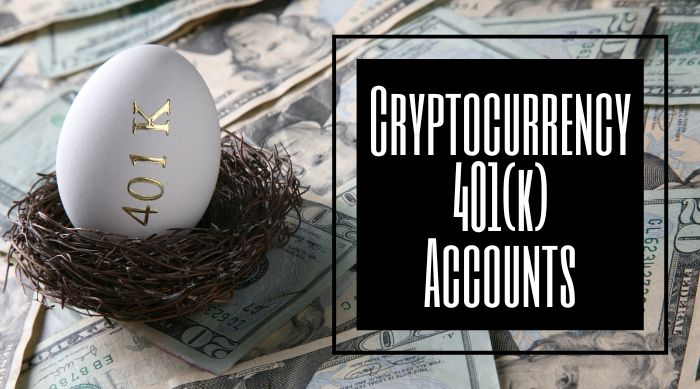Can you use cryptocurrency in a 401(k) retirement account? Adding the option would permit investors to hedge against certain kinds of losses; for some companies, the question of accepting Bitcoin into retirement accounts has already been answered.
That is because self-directed IRAs and self-directed 401(k)s have been (depending on the investment firm) Bitcoin-friendly for a while now.

In April 2022, Fidelity Investments made major headlines with an announcement that it would allow its investors to add Bitcoin to Fidelity customers’ 401(k) accounts. It was a groundbreaking move that simultaneously acknowledged the power of cryptocurrency while acknowledging its unregulated risks.
Fidelity’s move permits the use of Bitcoin in a 401(k) while restricting it (see below) presumably to keep unsuspecting investors from over-leveraging crypto or overinvesting in it in association with a 401(k) retirement plan.
What Is A 401(k) Retirement Account?
A 401(k) retirement investment account is considered a company-provided account that typically features both employer and employee both making contributions toward the retirement fund for the employee. There are “traditional” 401(k)s and Roth 401(k) plans, and many of the differences between the two have to do with how they may be taxed when funds are withdrawn.
There can be tax incentives for those who contribute to such plans. For traditional IRAs, the contributions are considered “pre-tax” whereas Roth IRA contributions are “after-tax” contributions.
The main difference between the two in this area is that traditional IRAs have a tax penalty for withdrawals, but Roth IRAs have no tax for withdrawals.
The contributions are invested by the agency managing the 401(k)s; these may go into a diverse range of investments you specify or choose with the help of your account manager. These investments may pay dividends from bonds, mutual funds, or stocks. 401(k) accounts typically feature annual contribution limits.
Adding Bitcoin To A 401(k)
Adding cryptocurrency to a 401(k) would be far more complicated for an investment house like Fidelity if they didn’t pick and choose specific currencies to support. At press time, only Bitcoin is acceptable to Fidelity. Will that change in the future?
If you own other cryptocurrencies and want to add crypto to a retirement account like a Fidelity 401(k) you may have to convert those other currencies to Bitcoin.
But prior to adding cryptocurrency to 401(k) accounts, it’s important to understand one key issue about Bitcoin. You don’t get dividends from it the same way you might from stock purchases. You won’t get a bond yield, and you won’t get a payout simply for holding Bitcoin.
That means that your Bitcoin potentially just sits there, riding the ups and downs of valuation in the marketplace. What good does it do to have a cryptocurrency 401(k) account if Bitcoin doesn’t generate any passive income the way a stock purchase or mutual fund might?
Bitcoin As A Store Of Value
When you look at your investment portfolio, including your 401(k), it’s a bad idea to think about crypto as being the same as a stock or bond.
For starters, stocks, bonds, Treasury Bills, bearer bonds, and related investments are all heavily regulated and there is far more predictable behavior (in specific contexts) from these regulated investments. And when it comes to your retirement finances, you definitely want more predictability.
All the players in the marketplace are expected to understand and abide by the rules. Crypto is far less controlled, which makes it an inherently risky proposition.
Add to that the fact that Bitcoin only “earns” money in real life when it is bought, sold, or traded. Are you thinking that Bitcoin sounds more like gold or silver than a 30-year Treasury Bill or Starbucks stock?
That is correct–gold and Bitcoin have more in common than gold and Walmart stock. Gold, silver, orange juice, hog futures, and more are commodities. They don’t necessarily earn interest or pay dividends, and trading conditions can be tough for a newcomer unused to dealing with volatility.
Bitcoin Volatility Versus Retirement Account Planning
Bitcoin stores value, and that makes it a potentially important part of any fully diversified investment portfolio. But if you over-buy Bitcoin you risk putting your investments at risk because crypto can so easily lose value quickly.
The speed of a single social media post is sometimes all it takes to significantly alter the value of Bitcoin. Do you really want a large amount of your investment money tied up in something so affected by the whims of social media? This is, after all, your retirement money we’re discussing here. The key is knowing the right percentage to invest.
Cryptocurrency 401(k) Accounts
Since there is at press time no federal regulation on cryptocurrency in any across-the-board way (in the context of this article) the specific requirements on a 401(k) account that accepts crypto will likely vary a great deal in some sectors, while conforming to a certain standard in others. The nature of the company may play a part in how liberal or conservative it is where Bitcoin investing goes.
You may find that traditional investing houses dabbling in crypto are likely to be more restrictive in their policies than those who have no exposure to U.S. government regulations in this area.
Why?
A March 2022 warning from the Department of Labor may provide a clue; the DOL issued a “compliance assistance release” about crypto and retirement investment accounts. That release included a statement on the DOL’s views of crypto.
The agency announced “serious concerns about the prudence of a fiduciary’s decision to expose a 401(k) plan’s participants to direct investments in cryptocurrencies, or other products whose value is tied to cryptocurrencies.”
New Horizons For Crypto?
This is a new investment type when compared to much older financial instruments like bonds and stock options and it may be years, even decades before realistic industry standards begin making their way across the DeFi and traditional banking landscapes.
In Fidelity’s case, the rules of engagement for adding Bitcoin to a 401(k) retirement account include a specific limit; you are only allowed to invest in Bitcoin up to 20% off your total Fidelity account.
Bitcoin Fees
Lest we neglect the other side of this coin, there are also new horizons for companies like Fidelity. You may be assessed Bitcoin fees in association with using your crypto in a retirement account. You could be charged a fee between 0.75% and 0.90% depending on circumstances, your employer’s 401(k) plan, and other variables.
Fees associated with retirement funds can be controversial even without Bitcoin. CNBC.com reports that a certain percentage of 401(k) users mistakenly believe their accounts are free. CNBC reports that a 2018 survey showed roughly one-third of those asked at the time didn’t realize the costs associated with maintaining a 401(k).
Bitcoin fees could add more to those costs; you’ll want to know what you will be charged for diversifying with crypto and how much those charges will add up over the lifetime of your account. Will you be charged for applying the crypto and again for cashing out? Know your fees before you commit.
What To Think About Before Adding Crypto To a 401(k)
In the early days of crypto and the lack of regulatory oversight accompanying them, there is an elevated risk in blending a heavily-regulated financial product like a 401(k) retirement account and the comparatively unregulated world of Bitcoin.
When the regulators finally do move in (and they will, it’s only a matter of time) the real question will be whether you have wasted your time trying to add crypto to your portfolio specifically for retirement purposes.
Purpose-Driven Investment
And for those who decide to make the investment in spite of the risks, there are important questions to ask, the most important being why you want to add Bitcoin to your retirement plan. Those who want to include Bitcoin just because it is new and interesting miss the point of retirement planning. Everything in your retirement account should be invested in for a reason.
For example, you would add mutual funds to your retirement plan because they represent a decreased risk and offer diversification options that make sense for a long-term investment plan. You would add bonds because these are even lower-risk opportunities you can buy and hold for a long time depending on the structure of the bond.
Have A Plan
So when you go to add Bitcoin to this mix, what is the utility? Do you have a strategy or a plan for your portfolio that Bitcoin can help you reach? For some, the potential store of value is one draw, but for others, it may be down to a misunderstanding of how and why diversified portfolios keep you safer.
If you are interested in crypto for its own sake, there’s no need to use it in your retirement plans; you’re free to invest in Bitcoin or any other currency without the need to submit to 401(k) rules and requirements. But if you have an endgame for the crypto you wish to invest in your retirement account, it might make sense to talk to a financial planner to learn what your options may be.
Remember, not all investment houses are on board with crypto and you may have to shop around to find the right services for you. State law, changes in federal regulations, and changes in company policies may all have an effect on your ability to connect your retirement fund with crypto.
Joe Wallace has covered real estate and financial topics, including crypto and NFTs since 1995. His work has appeared on Veteran.com, The Pentagon Channel, ABC and many print and online publications. Joe is a 13-year veteran of the United States Air Force and a former reporter for Air Force Television News.


